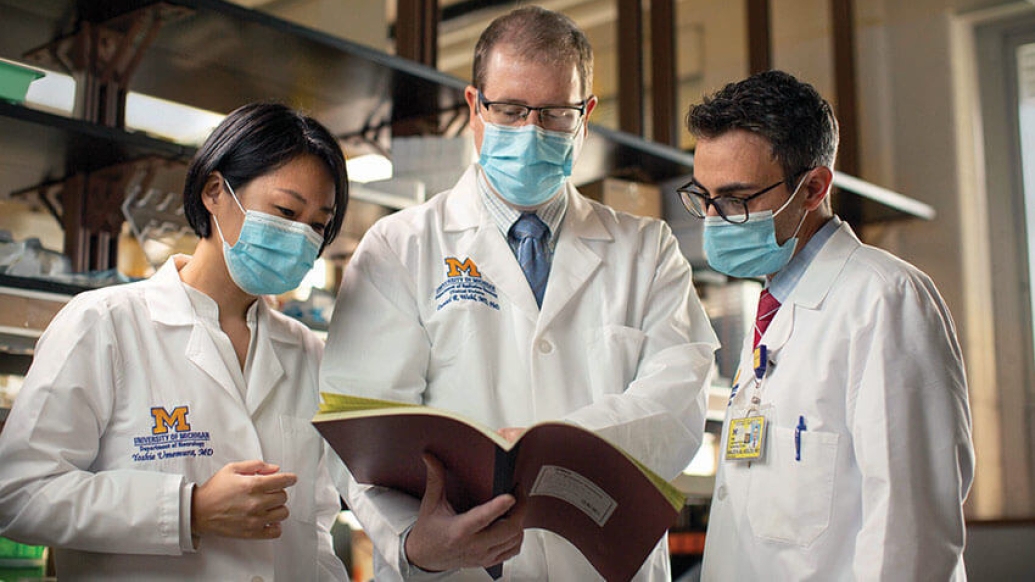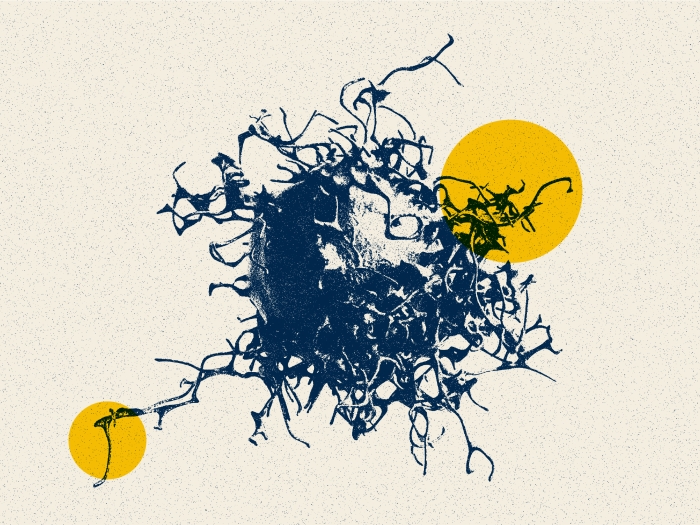The trial advances basic science research on the relationship between purine levels and treatment resistance to develop new treatment options for patients.
5:00 AM
Author |

A new clinical trial from a team at the University of Michigan Rogel Cancer Center uses innovative basic science research methods to offer hope and a new treatment to glioblastoma patients. A collaborative team of Rogel physicians, led by Daniel Wahl, M.D., Ph.D., hopes that grounding their trial in rigorous and innovative biology from the very beginning will help this approach succeed where so many other potential glioblastoma treatments have failed.
Exploring these types of advances in glioblastoma treatment is urgent. The aggressive brain tumor is largely resistant to current treatment, almost always recurs, and comes with a grim prognosis. Further, many new therapies fail to cross the blood-brain barrier, making drugs that would otherwise be effective often unable to reach the cancer cells. This reality of glioblastoma, and the lack of new effective treatments in the last 15 years, motivates Wahl and his team.
The clinical trial, which began in August 2020, has its foundation in Wahl's medical training and Ph.D. studying metabolism, all performed at U-M. While taking care of glioblastoma patients during a residency in radiation oncology, Wahl saw firsthand the consequences of these aggressive treatment-resistant brain tumors. Most glioblastoma patients live less than a year-and-a-half from diagnosis, and fewer than 5% live five or more years.
"Radiation is one of the few treatments that work for glioblastoma, but it doesn't work well enough," Wahl explained. "Because of how important metabolism is for so many biologic functions, and how different metabolism is in cancer cells compared to the normal body, I thought metabolic pathways might be partly to blame for this resistance."
First, Wahl needed to understand the relationship between metabolites—small nutrients like sugars, amino acids, and fats—and tumor treatment response. Measuring a variety of tumor models, Wahl's team searched for a correlation between the high levels of different metabolites and the tumor models with the highest radiation resistance. Toward the end of his post-doctoral fellowship, he and his team found what they were looking for. "Purines, the metabolites that are the building blocks of DNA, were really, really high in the brain tumors that were most resistant to radiation."
But how important was this finding? When more purines were added into a glioblastoma cell, did the cells become more resistant to radiation? If purine levels were decreased, did the tumor become more sensitive to radiation? The answers were a resounding yes.
"Not only were high purines associated with treatment resistance, they also caused treatment resistance," said Wahl.
With this, Wahl set out to see if this causal relationship between high purine levels and glioblastoma radiation resistance could be leveraged to make clinical treatments more effective. He looked for FDA-approved drugs on the market that altered purine levels and found mycophenolate mofetil, a purine blocker used to prevent organ rejection in transplant patients. Moreover, mycophenolate eliminated guanosine triphosphate, the main purine responsible for radiation resistance.
In the lab, Wahl's team explored using mycophenolate mofetil on glioblastoma tumors grown in mouse models. To their delight, the drug made radiation work better. "When we saw those lab results, we knew we had to write a clinical trial."
To do so, Wahl partnered with Yoshie Umemura, M.D., a neuro-oncologist at the Rogel Cancer Center and expert in clinical trial writing and design, and Wajd Al-Holou, M.D., a neurosurgeon specializing in oncology. Together they have developed the Michigan Medicine Multidisciplinary Brain Tumor Clinic, the first multi-disciplinary treatment-focused brain tumor clinic at the University of Michigan. In this clinic, Wahl, Umemura and Al-Holou see patients and determine treatment plans together. It was this clinic that "allowed us to develop ideas as a team to tackle this difficult problem," said Al-Holou.
The clinical trial started in August 2020 for patients with recurrent glioblastoma tumors who'd previously received radiation but whose tumors had returned. In the trial, these patients receive mycophenolate mofetil alongside additional radiation treatment. To date, the team has treated about a dozen patients, and has since expanded the bounds of the trial to include patients with new glioblastoma diagnoses, incorporating updated laboratory results showing that mycophenolate also made chemotherapy more effective. This arm of the trial started in late 2021 and five patients have been treated at the time of publication.
Like Podcasts? Add the Michigan Medicine News Break on iTunes, Google Podcasts or anywhere you listen to podcasts.
"It's all still ongoing and too early to tell, but so far, treatment has been really safe with no serious toxicities," said Wahl.
For Umemura, the strength of this trial lies in the symbiotic relationship between clinical care and lab research, and the collaboration amongst researchers.
"This trial has a rigorous basic science backbone to support the addition of an inexpensive drug that is widely available. If we can prove there is an added benefit in treatment efficacy—which would be the next step after we can show it's safe— then this treatment regimen is likely readily incorporated into clinical care without challenges in cost or accessibility for patients."
Barrier crossing
As the team gets further into the clinical trial, understanding how well the drug reaches the tumor stays a focus. Part of figuring out the efficacy of the purine blocker relies on finding a safe dosage strong enough to traverse the blood-brain barrier, which often renders glioblastoma treatments ineffective, and determining whether the drug has the expected effect. As Al-Holou describes, most clinical trials fail to understand the impact this barrier plays. Because of an inability to determine if drugs cross this barrier, researchers often remain puzzled at the last phase of a trial, uncertain about what, and when, things went wrong.
"The last major advancement in glioblastoma treatment was more than 15 years ago," Al-Holou noted. "Our team is not only bringing a new drug that hasn't been tried before, but we're also making sure it gets into the brain and does what it's supposed to do from the very beginning."
To do this, glioblastoma patients needing surgery receive mycophenolate before their procedure and then researchers freeze tumor tissue in the operating room. Later, Wahl and his laboratory team analyze this tumor tissue to determine how much mycophenolate reached the tumor and how well purine metabolism was blocked.
Wahl, Umemura and Al-Holou are also working to determine which glioblastoma patients are most likely to benefit from mycophenolate treatment. The team hypothesizes that patients whose tumors have high activity of purine metabolism, not just high purine levels, might benefit most from these drugs. Wahl likens this to traffic.
"Imagine a freeway full of speeding cars. Blocking a road like this would be disastrous. Now imagine a second freeway also full of cars, but they're not moving: like a traffic jam. Though the traffic jam is also full of cars, putting down a roadblock wouldn't matter much. We think that tumors making lots of purines are like that fast freeway and will be most affected by mycophenolate, which is the roadblock."
But as the research progressed, a problem emerged.
Standard analysis of tumor tissue just reveals how many purines are present (the number of cars). It doesn't tell how active purine synthesis is (how fast the cars are moving). So Wahl, Al-Holou and others teamed up to use a new method called Stable Isotope Tracing to measure how quickly purines are being made in patient tumors.
"We think we might be the very first people in the world to measure this metabolic pathway activity in a patient's brain tumor," said Wahl. "And now that we can measure it, it could help us figure out which patients will benefit the most from drugs that block it."
Staying the course
The trial still has a long way to go, and Wahl and his team hope to figure out a safe dose of mycophenolate that can be used alongside radiation and chemotherapy, and to get a hint of whether that dose might improve patient outcomes, in the next few years. Then, they'll be able to decide if the trial is ready to move to a randomized clinical trial, which would require hundreds of patients from across the country. The team is currently designing this phase with the Alliance for Clinical Oncology, a national cooperative group.
"It's not guaranteed that it will happen, but we're very optimistic," Wahl said.
But for these researchers, the use of innovative methods already garners hope for patients facing dire circumstances.
"It's exciting to be giving something new to patients who really, really need it. To be able to sit with a patient and say, 'We've been working hard to figure things out, and we now have something we can try,' is really meaningful and motivating."
This phase of the research Wahl's been pursuing for years is also personally gratifying.
"Right now, I get to use all my training, from thinking about atoms, molecules, mass spectrometry and metabolism, to studying cells and animal tumor models in the lab, to caring for patients hands-on and talking to them about a clinical trial. Each of these skills, and the skill and dedication of the great people I get to work with, like Dr. Umemura and Dr. Al-Holou, are required to create change for patients."

Explore a variety of healthcare news & stories by visiting the Health Lab home page for more articles.

Department of Communication at Michigan Medicine
Want top health & research news weekly? Sign up for Health Lab’s newsletters today!





